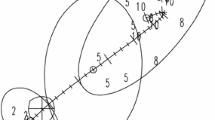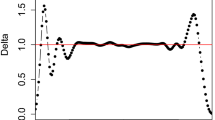Abstract
In this rejoinder, we address two of Ratcliff’s main concerns with respect to the EZ-diffusion model (Ratcliff, 2008). First, we introduce “robust-EZ,” a mixture model approach to achieve robustness against the presence of response contaminants that might otherwise distort parameter estimates. Second, we discuss an extension of the EZ model that allows the estimation of starting point as an additional parameter. Together with recently developed, user-friendly software programs for fitting the full diffusion model (Vandekerckhove & Tuerlinckx, 2007; Voss & Voss, 2007), the development of the EZ model and its extensions is part of a larger effort to make diffusion model analyses accessible to a broader audience, an effort that is long overdue.
Similar content being viewed by others
References
Brown, S. D., & Heathcote, A. J. (in press). The simplest complete model of choice reaction time: Linear ballistic accumulation. Cognitive Psychology.
Cox, D. R., & Miller, H. D. (1970). The theory of stochastic processes. London: Methuen.
Dolan, C. V., van der Maas, H. L. J., & Molenaar, P. C. M. (2002). A framework for ML estimation of parameters of (mixtures of) common reaction time distributions given optional truncation or censoring. Behavior Research Methods, Instruments, & Computers, 34, 304–323.
Forstmann, B. U., Dutilh, G., Brown, S., Neumann, J., von Cramon, D. Y., Ridderinkhof, K. R., & Wagenmakers, E.-J. (in press). Striatum and pre-SMA facilitate decision-making under time pressure. Proceedings of the National Academy of Sciences.
Grasman, R. P. P. P., Wagenmakers, E.-J., & van der Maas, H. L. J. (in press). On the mean and variance of response times under the diffusion model with an application to parameter estimation. Journal of Mathematical Psychology.
Heathcote, A. (1996). RTSYS: A DOS application for the analysis of reaction time data. Behavior Research Methods, Instruments, & Computers, 28, 427–445.
Hohle, R. H. (1965). Inferred components of reaction times as functions of foreperiod duration. Journal of Experimental Psychology, 69, 382–386.
Lo, C.-C., & Wang, X.-J. (2006). Cortico-basal ganglia circuit mechanism for a decision threshold in reaction time tasks. Nature Neuroscience, 9, 956–963.
Luce, R. D. (1986). Response times: Their role in inferring elementary mental organization. New York: Oxford University Press.
Ratcliff, R. (1978). A theory of memory retrieval. Psychological Review, 85, 59–108.
Ratcliff, R. (1979). Group reaction time distributions and an analysis of distribution statistics. Psychological Bulletin, 86, 446–461.
Ratcliff, R. (2008). The EZ diffusion method: Too EZ? Psychonomic Bulletin & Review, 15, 1218–1228.
Ratcliff, R., & McKoon, G. (2008). The diffusion decision model: Theory and data for two-choice decision tasks. Neural Computation, 20, 873–922.
Ratcliff, R., & Smith, P. L. (2004). A comparison of sequential sampling models for two-choice reaction time. Psychological Review, 111, 333–367.
Ratcliff, R., & Tuerlinckx, F. (2002). Estimating parameters of the diffusion model: Approaches to dealing with contaminant reaction times and parameter variability. Psychonomic Bulletin & Review, 9, 438–481.
R Development Core Team (2004). R: A language and environment for statistical computing. Vienna: Author.
Tuerlinckx, F. (2004). The efficient computation of the cumulative distribution and probability density functions in the diffusion model. Behavior Research Methods, Instruments, & Computers, 36, 702–716.
Tukey, J. W. (1977). Exploratory data analysis. Reading, MA: Addison-Wesley.
Vandekerckhove, J., & Tuerlinckx, F. (2007). Fitting the Ratcliff diffusion model to experimental data. Psychonomic Bulletin & Review, 14, 1011–1026.
Vandekerckhove, J., & Tuerlinckx, F. (2008). Diffusion model analysis with MATLAB: A DMAT primer. Behavior Research Methods, 40, 61–72.
Voss, A., & Voss, J. (2007). Fast-dm: A free program for efficient diffusion model analysis. Behavior Research Methods, 39, 767–775.
Voss, A., & Voss, J. (2008). A fast numerical algorithm for the estimation of diffusion model parameters. Journal of Mathematical Psychology, 52, 1–9.
Wagenmakers, E.-J. (in press). Methodological and empirical developments for the Ratcliff diffusion model of response times and accuracy. European Journal of Cognitive Psychology.
Wagenmakers, E.-J., van der Maas, H. J. L., & Grasman, R. P. P. P. (2007). An EZ-diffusion model for response time and accuracy. Psychonomic Bulletin & Review, 14, 3–22.
Author information
Authors and Affiliations
Corresponding author
Rights and permissions
About this article
Cite this article
Wagenmakers, EJ., van der Maas, H.L.J., Dolan, C.V. et al. EZ does it! Extensions of the EZ-diffusion model. Psychonomic Bulletin & Review 15, 1229–1235 (2008). https://doi.org/10.3758/PBR.15.6.1229
Received:
Accepted:
Published:
Issue Date:
DOI: https://doi.org/10.3758/PBR.15.6.1229




